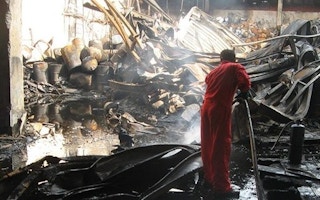After any disaster, whether it’s a fire, flooding or chemical spillage, what happens to the large volumes of waste materials left behind? Can any of the materials be salvaged, restored or upcycled?
With Blue Planet’s latest acquisition of disaster recovery and restoration company Disaster Restoration Singapore (DRS), the company can now manage the sustainable handling and disposal of these various waste materials.
“An integrated hazardous waste management ecosystem can segregate, process, and upcycle waste from disaster sites in an environmentally friendly and efficient manner,” said Bradley Chew, director of Blue Planet.
“At Blue Planet, we’re not looking to dispose of waste. We’re looking to extract value from what other people call waste—to process and utilise it—so that we prevent waste in the overall system,” Chew added.
Disaster sites are known to generate significant levels of industrial and commercial waste—some of it toxic or hazardous in nature.
The first step to disaster recovery is rapid assessment and containment of the situation, followed by a risk assessment and response plan and then careful execution of the plan without any further endangerment to the people or environment of the disaster site.
“Disasters are unpredictable by nature, in their size and scale. But disasters inevitably create large quantities of waste materials or debris. Each category of waste will need to be assessed and then channelled into the appropriate treatment and disposal process,” said Chew.
In order to handle the complexity and diversity in emergency situations, an integrated process housed under one collaborative corporate roof is needed to yield seamless results, said Chew. “There is no time or place for error with emergency response and disaster recovery.”
A big part of the process includes preservation and loss prevention of the disaster site. Chew cited the example of a process he calls “time freezing”, in which the company deploys technologies that dehumidify the site to prevent further corrosion from occurring.
The damaged equipment from the disaster site is then transported away and washed down, before being returned to the site within twenty-four hours. “Sometimes we manage to restore the equipment to a condition that is even better than its pre-loss condition,” said Chew.
Beyond hazardous waste management
“Blue Planet now has the ability to handle waste in highly specialised areas. This aligns with our vision of creating an integrated approach to waste, with a zero waste to landfill policy,” Chew added.
Integrated waste management combines a variety of strategies for both waste management and reduction, including collection and transportation, segregation, processing and treatment, and disposal, with an emphasis on maximising resource use efficiency and minimising impact on the environment.
“As our integrated materials reclamation processes lead to fewer materials being disposed of into incinerators or landfills, our solutions are not only better for the environment, but are most cost-effective as well,” Chew said.
The company has identified how different technologies are able to work together to create a closed loop approach to waste.
“I like to describe what we do as a technological jigsaw. We’ve created an ecosystem of technologies that can deal with all aspects of waste management, where the inputs of one technology can feed into the other,” Chew said.
Currently, Blue Planet companies process more than 15,000 tonnes of waste a day, and have deployed more than 70 decentralised organic waste units across South Asia. The company also deals with non-hazardous waste recovery, large-scale landfill remediation and green building waste solutions in the region.
Its future plans include acquiring companies to fill the current gaps in their portfolio—for example technologies that deal with waste generated by solar panels and medical equipment.











